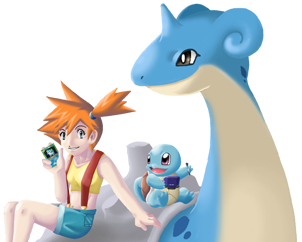PokéBeach's Spriting Tutorial
Hello, and welcome to the wonderful world of spriting. We spriters made this tutorial for those who want to get into spriting, or are already into spriting and need help. Hope you enjoy.
Why Sprite?
Spriting is very enjoyable. If you're bored, it provides something to do, and once you get experienced enough, you can impress other members, make a gallery, and maybe even open your own shop.Plus, spriting gets you the girls 
(JK)
Introduction to Sprites
Red/Blue

Ah, the classics. Nothing beats those. But, of course, being old as they are, the sprites aren't too good.
First, we'll break down the composition of an R/B sprite. Always coming from the top right in R/B is the light source (where the sun, or any other type of light, is. This gives the Pokémon shading.) Also facing top-right are the highlights, the places where the light hits the Pokémon the most, illustrated by lighter shades. Next to almost all the highlights is the base color, which is the color this sprite would be if it didn't have any shading whatsoever. The shadow color is used in spots where the light source hits the Pokémon the least, illustrated by darker shades. The outline (all of you should know what an outline is) of R/B sprites is typically black, or some color close to it.
After the shading details, we'll look at the extras, which contain two parts: facial features (including eyes, mouth, nose, etc.), and anything else on the sprite, such as spots, wings, horns, etc.
So, a few things to keep in mind when you're working with R/B sprites:
Yellow/Green
Gold/Silver
Hello, and welcome to the wonderful world of spriting. We spriters made this tutorial for those who want to get into spriting, or are already into spriting and need help. Hope you enjoy.
Why Sprite?
Spriting is very enjoyable. If you're bored, it provides something to do, and once you get experienced enough, you can impress other members, make a gallery, and maybe even open your own shop.
Introduction to Sprites
Red/Blue
Ah, the classics. Nothing beats those. But, of course, being old as they are, the sprites aren't too good.
First, we'll break down the composition of an R/B sprite. Always coming from the top right in R/B is the light source (where the sun, or any other type of light, is. This gives the Pokémon shading.) Also facing top-right are the highlights, the places where the light hits the Pokémon the most, illustrated by lighter shades. Next to almost all the highlights is the base color, which is the color this sprite would be if it didn't have any shading whatsoever. The shadow color is used in spots where the light source hits the Pokémon the least, illustrated by darker shades. The outline (all of you should know what an outline is) of R/B sprites is typically black, or some color close to it.
After the shading details, we'll look at the extras, which contain two parts: facial features (including eyes, mouth, nose, etc.), and anything else on the sprite, such as spots, wings, horns, etc.
So, a few things to keep in mind when you're working with R/B sprites:
- The light always comes from the top right
- There are three total shades
- The outlines are black or nearly so
- The highlights are white or nearly so
- The extra features are not very detailed
Yellow/Green
Gold/Silver

